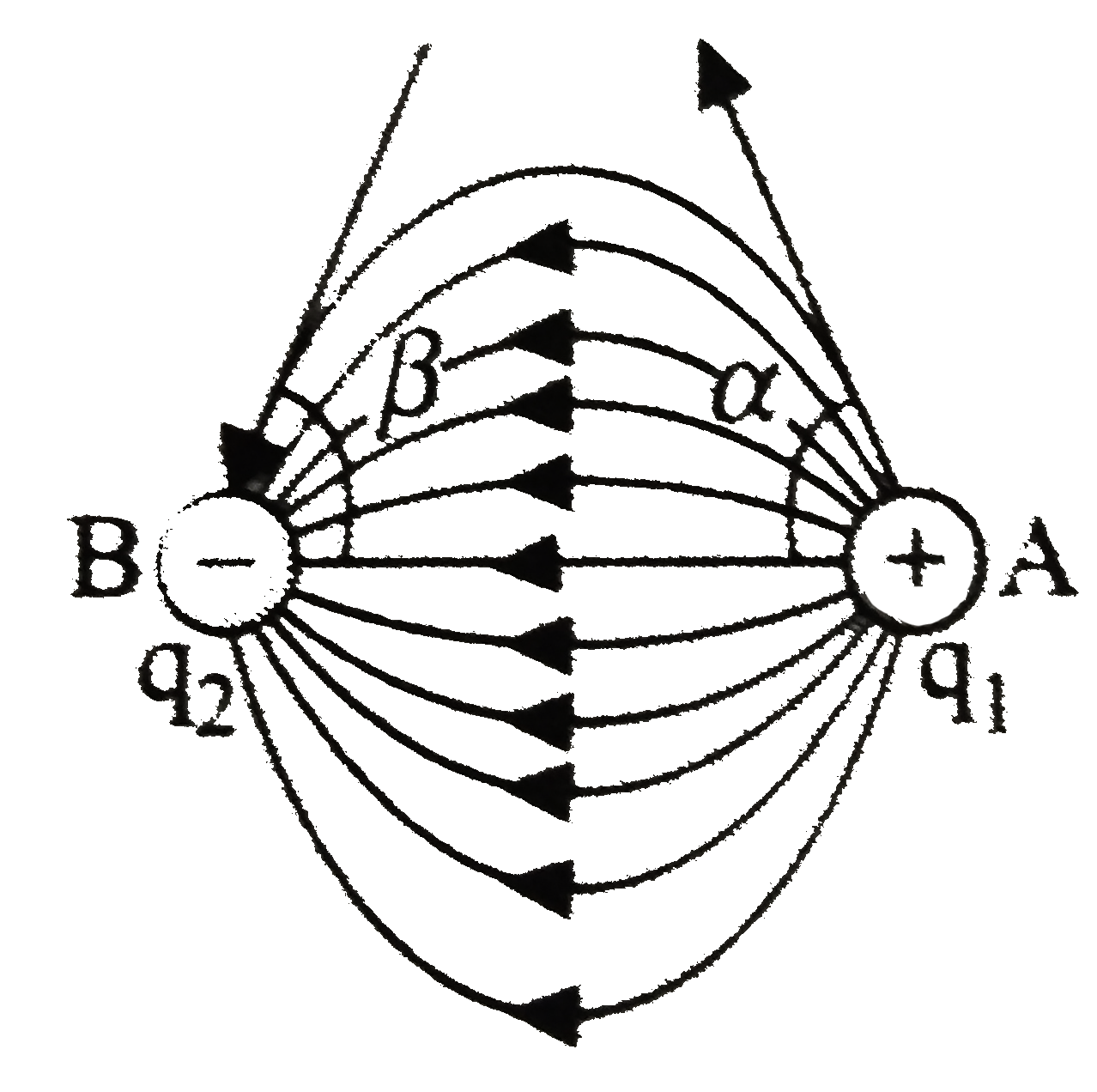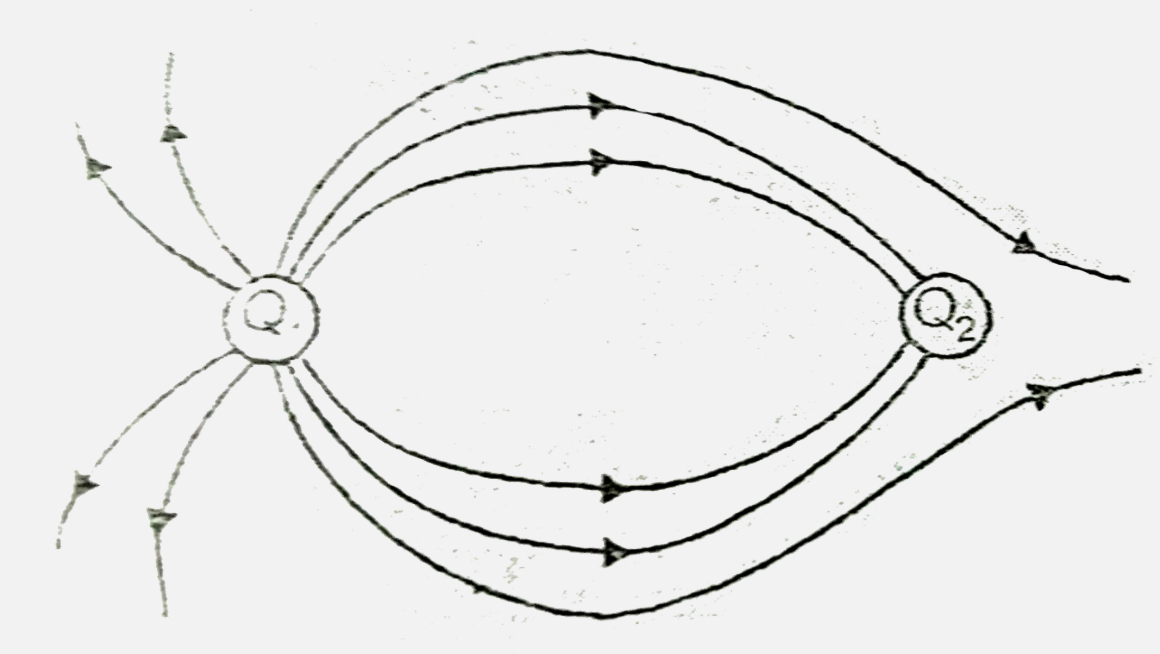Two charges+q1 and −q2 are placed at A and B respectively. A line of force emanates from q1 at an angle α with the line AB. At what angle will it terminate at −q2 ?
 Solution in Gujrati
Solution in Gujrati
The correct Answer is:2sin−1[(sinα2)√q1q2]
Solid angle =2π(1−cosα)
q12∈0(1−cosα)=q22∈0(1−cosθ)
q1sin2α2=q2sin2θ2
sinθ2=√q1q2sinα2
θ=2sin−1[√q1q2sinα2]

Topper's Solved these Questions
- MISCELLANEOUSBOOK - ALLEN CHAPTER - MISCELLANEOUSEXERCISE - Exercise-05(A)
35 Videos
- MISCELLANEOUSBOOK - ALLEN CHAPTER - MISCELLANEOUSEXERCISE - Exercise-05(B)
19 Videos
- MISCELLANEOUSBOOK - ALLEN CHAPTER - MISCELLANEOUSEXERCISE - Exersice-04[A]
34 Videos
- KINEMATICS (MOTION ALONG A STRAIGHT LINE AND MOTION IN A PLANE)BOOK - ALLEN CHAPTER - KINEMATICS (MOTION ALONG A STRAIGHT LINE AND MOTION IN A PLANE)EXERCISE - BEGINNER S BOX-7
8 Videos
- PHYSICAL WORLD, UNITS AND DIMENSIONS & ERRORS IN MEASUREMENT BOOK - ALLEN CHAPTER - PHYSICAL WORLD, UNITS AND DIMENSIONS & ERRORS IN MEASUREMENT EXERCISE - EXERCISE-IV
7 Videos
Similar Questions
On moving a charge of 20 coulomb by 2cm, 2J of work is done , the potential difference between the points is .
View SolutionA charge +q is fixed at each of the points x=x0, x=3x0, x=5x0,…………x=∞ on the x axis, and a charge −q is fixed at each of the points x=2x0, x=4x0, x=6x0, …………x=∞. Here x0 is a positive constant. Take the electric potential at a point due to a charge Q at a distance r from it to be Q/(4πε0r).Then, the potential at the origin due to the above system of
View SolutionThree particles, each of mass m and carrying a charge q each, are suspended from a common point by insulating mass-less strings each of length L. If the particles are in equilibrium and are located at the corners of an equilateral triangle of side a, calculate the charge q on each particle. Assume L>>a.
View SolutionA football player kicks a ball at an angle of 30∘ with an initial speed of 20 m/s. Assuming that the ball travels in a vertical plane, calculate (a) the time at which the ball reaches the highest point (b) the maximum height reached (c) the horizontal range of the ball (d) the time for which the ball is in the air, (g=10m/s2)
View SolutionAssertion : Gravitational forces do not depend on the medium between the masses.
Reason : Mediating particle responsible for gravitational force is graviton.
View SolutionTwo charges +q_(1) and -q_(2) are placed at A and B respectively. A line of force emanates from q_(1) at an angle alpha with the line AB. At what angle will it terminate at -q_(2) ?
View SolutionThree charged paricles are placed on a straight line as shown in fig. q_(1) and q_(2) are fixed but q_(3) can be moved. Under the action of the forces from q_(1),q_(2) and q_(3) is in equilbrium. What is the relation between q_(1) and q_(2) .
View SolutionAssertion: Two charges q_(1) and q_(2) are placed at separation r . Then magnitude of the force on each charge is F . Reason: Now a third charge q_(3) is placed near q_(1) and q_(2) . Then force on q_(1) and q_(2) remains F .
View SolutionWhen two charges q1andq2 are kept at some distance apart, force acting between these charges is F. If a third change q3 is placed quite close to q3 is placed quite close to q2 what will happen to the force between q1andq2 ?
View SolutionTwo point charges +q1 and −q2 are placed at A and B respectvely. An electric line of force emerges from q1 making an angle α=60∘ with line AB and terminates as −q2 making an angle of 90∘ with line AB.
(a). Find ∣∣∣q1q2∣∣∣ ltbr> (b). Find the maximum value of angle α at which a line emitted from q1 terminates on charge q2.

View SolutionAn electrostatic field line leaves at an angle alpha from pint change q_(1) and connects with point charge -q_(2) at an angle beta ( q_(1) and q_(2) are positive) (see figure below). If q_(2)=3/2 q_(1) and alpha=30^(@) , then
View Solutionq1 और q2 इस प्रकार के बिंदु आवेश है कि q1×q2>0 दोनों आवेशों के बीच बल की क्या प्रकृति है?
View SolutionLooking at the various electric lines of forces between charges Q1 and Q2, find the value of Q1Q2.

View Solutionचित्र 2.58 में बिन्दु आवेश q1 और q2 की वैद्युत क्षेत्र रेखाएँ दिखाई गई है। q1 और q2 के क्या-क्या चिह्न हैं? यदि रेखाएँ आवेश के अनुपात में खींची गईं हों, तो अनुपात q1/q2 क्या है?

View Solutionदो समरूप चालक गेंद A व B पर क्रमशः धनात्मक आवेश q1वq2 है | किन्तु q1≠q2 है | दोनों बॉल को परस्पर स्पर्श किया जाता है तथा फिर उन्हें पूर्व स्थिति में ही रख दिया जाता हैं | आवेशों के मध्य बल होगा
View SolutionElectric force between two point charges q_(1) and q_(2) at rest is F. Now is a charge -q_(1) is placed next to q_(1) . What will be the (a) force on q_(2) due to q_(1) (b) total force on q_(2) ?
View Solution
